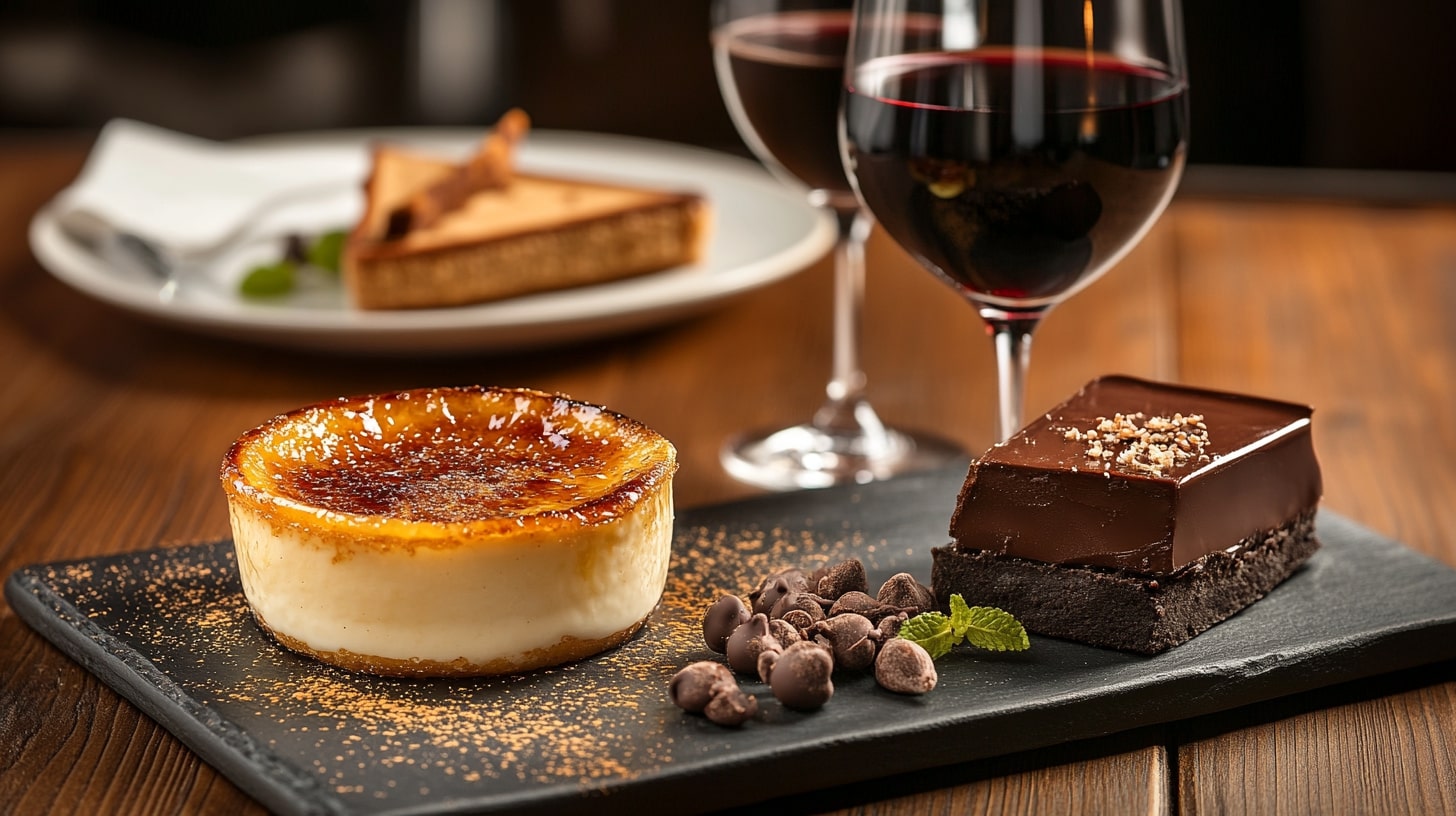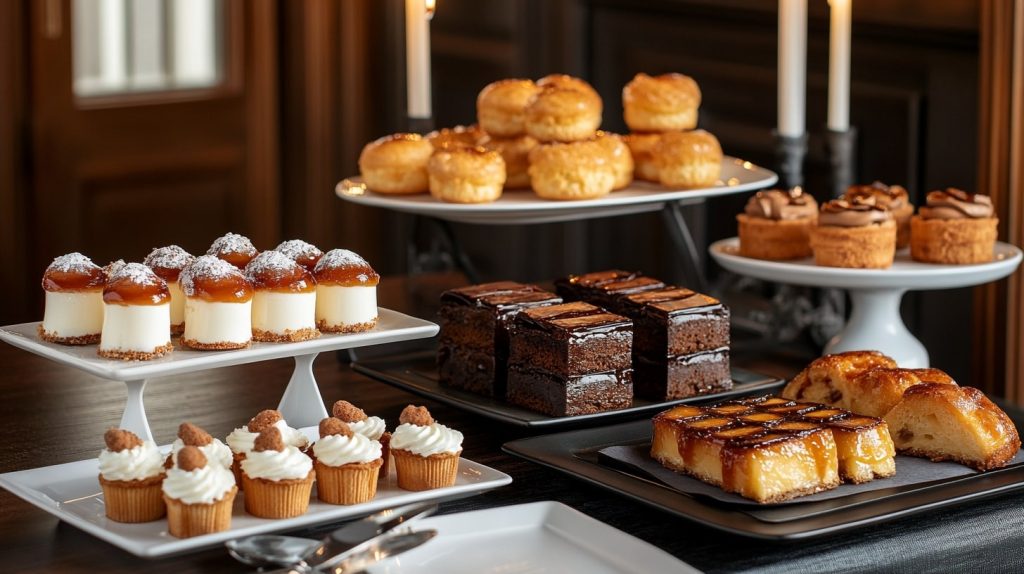
In this exploration, we’ll delve into how these two realms can pair beautifully to elevate your dining experience. We’ll cover the fundamentals of pairing wines and desserts, guiding you through the nuances of selecting the perfect match.
Whether it’s choosing between white, red, or sparkling wines, or discovering how champagne can complement a sweet finale, this guide will enhance your appreciation for these sophisticated indulgences. Join us as we unlock the secrets to perfect dessert pairings, a testament to French culinary excellence.
The fundamentals dos and don’ts in wine and desserts pairings
Pairing wine with desserts can be an art form, requiring a delicate balance of flavors to enhance the dining experience.
A fundamental rule is to ensure that the wine is at least as sweet, if not sweeter, than the dessert being served. This prevents the wine from tasting bitter or dull in comparison to the sweetness of the dessert. Typically, light desserts pair best with lighter wines; for instance, a zesty lemon tart might shine with a crisp, sweet Riesling. On the other hand, rich chocolate desserts often find their match in robust wines like a full-bodied tawny Port, which can complement the depth of the chocolate.
It’s generally advisable to avoid pairing dry wines with sweet desserts, as the contrast can be jarring and unappealing. By considering the main flavor elements of both the dessert and the wine (whether fruity, chocolatey, nutty, or spicy), you can create harmonious pairings that will bring out both the dish and the drink.
Red, white, rosé, sparkling, which wine to choose for dessert?
No, you can’t drink any wine for dessert! There are rules to follow if you want to create the perfect match. Choosing the right wine depends greatly on the dessert selected. Red wines, with their bold flavors, pair splendidly with dark chocolate mousse, as the tannins complement the bitterness of the chocolate. For desserts featuring berries or red fruits, a sweet rosé can provide a refreshing and harmonious balance.
White wines, particularly those that are sweet and fruity, are excellent with lighter desserts such as fruit tarts or custards, enhancing the delicate flavors without overpowering them. A simple almond-based cake or other nut-based cakes with their subtle sweetness and nutty flavors can be enhanced by the mineral and fruit undertones of dry Riesling.
Sparkling wines, including champagne, are versatile companions for a range of desserts. Their effervescence offers a palate-cleansing effect that is particularly delightful with creamy or rich desserts. And for that truly Oh La La! celebratory touch, a glass of champagne can elevate even simple desserts like strawberries or a white chocolate custard, making it a perfect choice for an impressive end to any meal.
How do I choose a dessert wine for a specific dish?
This involves understanding the dominant flavors and textures of your chosen dessert. For chocolate desserts, which are rich and often have deep, bitter notes, a fortified wine like Banyuls from Southern France complements beautifully. This wine enhances the chocolate’s richness without being overshadowed. For instance, a classic pairing would be a chocolate ganache tart with Banyuls.
Fruit-based desserts, like a caramelized tarte tatin, pair delightfully with a slightly sweet French wine that can contrast the tartness and sweetness of the fruit. A good choice would be a demi-sec Vouvray from the Loire Valley, which adds a gentle sweetness and complexity to balance the baked apple flavors in the tarte tatin.
For creamy desserts such as crème brûlée, a wine with acidity and effervescence can cut through the richness of the cream. A sparkling wine like a sweet Champagne from the Champagne region works wonderfully, offering a refreshing counterpoint to the creamy, caramelized top of the crème brûlée while enhancing the overall flavor profile. Each pairing aims to either complement or interestingly contrast the dessert’s main elements, creating a harmonious end to your meal.

What is the best dessert to serve with Champagne?
Beyond crème brûlée, other desserts also pair beautifully with Champagne. Light and airy macarons are excellent choices; their subtle flavors can harmonize with the nuanced notes of Champagne without overwhelming the palate.
Similarly, a fruit-based dessert such as a peach cobbler or a berry pavlova enhances the fresh, crisp qualities of Champagne, making for a refreshing and elegant dessert pairing. Madeleines are an excellent choice too. These small, sponge-like cakes are light in flavor, typically lemon or vanilla, making them a delightful match for a crisp brut Champagne.
These options highlight the versatility of Champagne as a perfect accompaniment to a variety of dessert choices, each enhancing the celebratory sparkle of the wine.
Conclusion
You do not have to be French to master the art of pairing wine with dessert! Learning the basics is really easy and it will enrich any dining experience, elevating both the flavors on your plate and the spirits in your glass.
Whether opting for the rich depth of a red with chocolate or the effervescent touch of sparkling wine with a creamy creation, the right combination can transform your meal’s finale.
Explore these pairings to discover how a well-chosen wine can highlight and harmonize with your dessert, making each bite and sip a celebration.
À votre santé !



